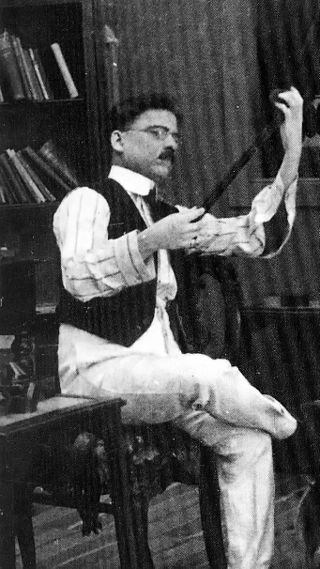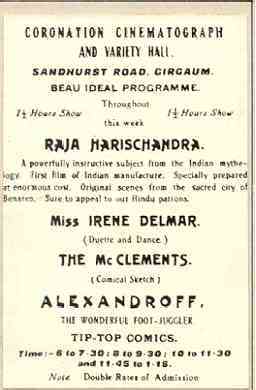
Prithviraj Kapoor was an Indian actor who is also considered to be one of the founding figures of Hindi cinema. He was associated with IPTA as one of its founding members and established the Prithvi Theatres in 1944 as a travelling theatre company based in Bombay.

Dhundiraj Govind Phalke, popularly known as Dadasaheb Phalke, was an Indian producer-director-screenwriter, known as "the Father of Indian cinema".

Raja Harishchandra is a 1913 Indian silent film directed and produced by Dadasaheb Phalke. It is often considered the first full-length Indian feature film. Raja Harishchandra features Dattatraya Damodar Dabke, Anna Salunke, Bhalchandra Phalke. and Gajanan Vasudev Sane. It is based on the legend of Harishchandra, with Dabke portraying the title character. The film, being silent, had English, Marathi, and Hindi-language intertitles.

Patience Cooper was an Anglo-Indian actress, and one of the early superstars of Bollywood. She was the daughter of Phoebe Stella Gamble (born in Calcutta in 1881; daughter of John Frederick Gamble and Phoebe Stella Clement whose mother was Armenian and James Alfred Cooper. An Anglo-Indian born in Howrah, West Bengal, and baptised on 30 May 1905, Cooper had a successful career in both silent and sound films. She is credited with the first double roles of Indian cinema—as twin sisters in Patni Prataap and as mother and daughter in Kashmiri Sundari, even though earlier in 1917, actor Anna Salunke had played roles of both the male lead character Ram and the female lead character Seeta in the film Lanka Dahan.
The life of Siddhartha Gautama, the Buddha, has been the subject of several films.
D. D. Dabke or Dattatraya Damodar Dabke was an actor in the first ever Indian full length silent film Raja Harishchandra, directed by Dadasaheb Phalke in 1913. He co-starred with Anna Salunke. He acted in three more movies Satyavadi Raja Harishchandra (1917), Lanka Dahan (1917), Shri Krishna Janma (1918) and later became a cinematographer, as well as a director. He directed the 1924 remake of Raja Harishchandra
Coronation Cinematograph and Variety Hall was a hall in the Girgaon area of south Mumbai, India, used for variety entertainment shows, dramas and to screen movies.

Satyawadi Raja Harishchandra is a 1917 silent black and white Indian film based on Hindu mythology, directed by Rustomji Dhotiwala. It was produced by J. F. Madan's Elphinstone Bioscope. Credited as the first remake in Indian cinema, the film is a remake of the first Indian feature film, Raja Harishchandra (1913) and was also inspired by an Urdu language drama, Harishchandra. The film is based on the mythological story of a Hindu King Harishchandra, the 36th king of the Solar Dynasty, who donated his entire kingdom and sold himself and his family to keep the promise given to the sage Vishvamitra in the dream. It is also the first feature film made in Calcutta. The intertitles used in the film were in Bengali language as the film was a silent film. The film was released on 24 March 1917 at New Tent Maidan, Calcutta.
The Indian Animation Industry encompasses traditional 2D animation, 3D animation and visual effects for feature films. In 1956, Disney Studios animator Clair Weeks, who had worked on Bambi, was invited to Films Division of India in Mumbai to establish and train the country's first animation studio as part of the American technical co-operation mission. He trained a core group of Indian animators, whose first production was a film called The Banyan Deer (1957). Veteran animator Ram Mohan started his career at Films Division's Cartoon Unit.
The 1st National Film Awards, presented by Ministry of Information and Broadcasting, India to felicitate the best of Indian Cinema released in the year 1953. Ceremony took place at Vigyan Bhavan, New Delhi on 10 October 1954 and awards were given by then President of India, Rajendra Prasad.

Shree Pundalik, which was released on 18 May 1912 at the Coronation Cinematograph, Girgaum, Mumbai, is sometimes considered the first feature-length Indian film by a minority. The government of India and most scholarly sources consider Raja Harishchandra to be the first Indian feature film, and detractors argue Pundalik was only a photographic recording of a popular play. It was produced and directed by Dadasaheb Torne.

Kamlabai Gokhale was one of the first actresses in Indian cinema, along with her mother Durgabai Kamat.
Trymbak B. Telang was an early Indian cinematographer. He was trained in the operation of the Williamson camera. He shot for films such as Raja Harishchandra (1913) and Satyavadi Raja Harishchandra and Lanka Dahan (1917).
Satyavadi Raja Harishchandra is a 1917 silent black and white Indian short film directed and produced by Dhundiraj Govind Phalke. The film is a shorter version of the first Indian feature film, Raja Harishchandra (1913), also directed and produced by Phalke. The intertitles used in the film were in Marathi language as the film was a silent film. The film is based on the mythological story of a Hindu King Harishchandra, the 36th king of the Solar Dynasty, who donated his entire kingdom and sold himself and his family to keep the promise given to the sage Vishvamitra in the dream.

Lanka Dahan is a 1917 Indian silent film directed by Dadasaheb Phalke. Phalke also wrote the film based on an episode of the Hindu epic Ramayana, credited to Valmiki. The film was Phalke's second feature film after the 1913 Raja Harishchandra, which was the first Indian full-length feature film. Phalke also directed various short films in between.
Mohini Bhasmasur is a 1913 Indian mythological film directed by Dadasaheb Phalke and starring Kamlabai Gokhale and Durgabai Kamat. It is India's and Phalke's second full-length feature film. Mohini Bhasmasur is the first Indian film to have a female actor. In Raja Harischandra, India's and Phalke's first film, the role of the female was played by Anna Salunke, a male.

Kanjibhai Rathod was an Indian film director.

Rattihalli Nagendra Rao was an Indian theatre actor, film actor and director in South Indian cinema. Following his career in theatre, Rao turned to film a where he became an actor, director, producer, screenwriter and occasional composer. He is considered one of the most influential personalities in the history of South Indian cinema.
The history of animation in India can be traced to the early 20th century. Precursors to modern animation such as shadow puppets and slide shows entertained audiences before the advent of the cinema. Pioneers such as Dadasaheb Phalke, Gunamoy Banerjee, K.S. Gupte and G.K. Ghokle kept the tradition of animation alive during the first half of the 20th century. Such individuals were usually self-taught and were inspired by foreign cartoons.










